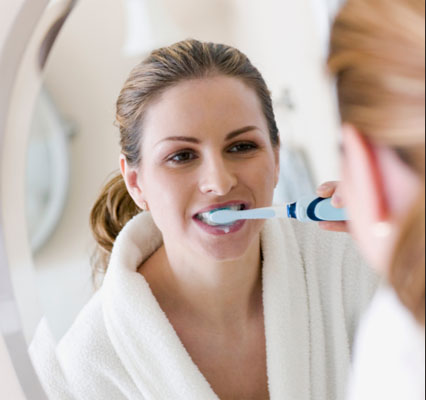How to brush your teeth like a pro
By Catalogs Editorial Staff

Learn how to brush your teeth like a pro for the best oral health
Proper care for teeth and gums is a critical component of oral health. Brushing is something people learn at a very early age and yet many use improper techniques or don?t do it for nearly long enough. Making a few adjustments will minimize the risk of gum disease, cavities, tooth decay and other issues.
Learning how to brush your teeth like a pro is easy, but you also need to remember every step and practice them every time you brush. The first step may surprise you: take good care of your toothbrush, making sure that it is sanitized after after every use and that it doesn’t spread germs back into your mouth. Invest in a toothbrush sanitizer for your bathroom.
Whether you prefer using a manual or electric toothbrush, the following guidelines apply:
- Use fluoride toothpaste and brush for a minimum of two minutes twice a day (at least) ? as soon as you wake up and before going to sleep.
- Floss at least once a day before going to sleep.
- Minimize snacking, particularly sweet snacks. When you eat between meals, clean after when possible.
- Get an oral exam and a cleaning at the dentist twice a year. Always follow up on your dentist?s recommendations. For example, sometimes they?ll suggest switching to a specific type of brush.
The right way
Two minutes, or 120 seconds, can feel like a long time when it?s the end of the night and all you want to do is sleep. But it?s incredibly important to spend at least two minutes brushing every time. That?s why electric toothbrushes are programmed to spin for two minutes. This takes away the guesswork because most of the time we underestimate how long we spend.
~
If yours is manual, set a stop watch or alarm for two minutes. Do this until you have a solid feel for this time length, or simply make a habit out of setting a timer.
The best method for how to brush your teeth like a pro is with gentle, short strokes. Clean each section of your mouth starting with the outer surfaces of the top then bottom teeth. Focus on the gumline and angle the brush about 45 degrees from the gumline. Note that each stroke should move away from the gums.
Next go over the back inner areas of the top then bottom ? these are harder to reach so be precise. Use small, back and forth strokes over each tooth.
When you get to the chewing surfaces, pay special attention crowns, parts surrounding fillings and any other areas where you?ve had work done. Remove additional bacteria and eliminate bad breath by cleaning your tongue, too.
Rinse your mouth with water, followed by mouthwash. Clean the brush with hot water.
Choosing a toothbrush
In general, soft bristled brushes with small heads will do the best job of removing plaque and bacteria from the mouth. The small heads allow you to get into those difficult areas. Many people who try a powered one never go back to manual. Electric toothbrushes clean better and make it easier for people with limited dexterity stay healthy.
Replace toothbrushes or the heads of powered ones at least once every three months or as soon as the bristles begin to warp. If you get sick, replace or sanitize it right away or remaining bacteria can lead to infection.
Don?t forget to floss
Wrap the ends of an 18-to-24 inch length of floss around your fingers and hold taut. Move it back and forth between the teeth, along the sides of each one. Pay special attention to areas that offer resistance.
Choosing toothpaste
Knowing how to brush your teeth like a pro also means choosing the best toothpaste for you. Don?t settle for whatever brand happens to be on sale – your oral health is too important. There are many different types available to meet different sets of needs. Whether you?re prone to cavities, tartar, sensitivity, stains or gingivitis, find one that fits your needs.
Popular Savings Offers











